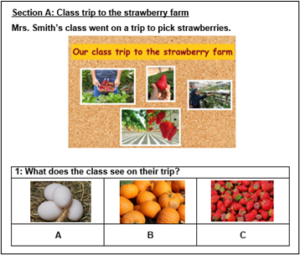Aniqa Leena discusses how she developed new, teacher-friendly tests to assess multilingual pupils’ English language proficiency as part of the Talk Rich Teaching (TRT) project.
How do you capture something when the tool you need simply doesn’t exist yet? The conclusion I eventually came to was to make it myself!
When I started my PhD studies back in 2020, one of my first tasks was to find out how schools assess their multilingual learners’ (MLLs) proficiency in English – but I quickly learnt that this can look different in schools across the country (Evans et al., 2016). Researchers can use technical materials to assess children’s language and literacy, but there is an absence of teacher-friendly ways to do so in school. For the TRT project, I wanted to find a way to measure our multilingual pupils’ English language and literacy in ways that considered the practicalities of classroom-based assessment whilst still maintaining academic rigour. The materials also needed to be age appropriate for our wonderful participating pupils in Year 1 or Year 4. So not a particularly long wish list(!)
On the hunt for materials
Some organisations such as The Bell Foundation and NASSEA have published valuable detailed assessment frameworks to help teachers assess their pupils’ language proficiency. However, for the TRT project we need pre-and post-tests that would show us whether teaching using the EPL makes a difference to progress in language and literacy for MLLs. This meant I needed tests that were more fine-grained and ‘measurable’ and for these I extended my search beyond the UK.
I approached the World-Class Instructional Design and Assessment (WIDA) consortium, based at the Wisconsin Centre for Educational Research in the United States. They specialise in creating resources to assess multilingual learners proficiency in practitioner-friendly formats, and have published a myriad of resources that are used by schools worldwide (WIDA, 2021).
It was clear that the WIDA materials would be a great fit for the TRT project. Eventually, with WIDA’s generous support and permission, I adapted a suite of their English language proficiency tests for the purposes of our study. I’d like to take this opportunity to express my warmest thanks to the WIDA team for sharing their published tests in this way.
Developing tests for the TRT project
The purpose of these tests is to assess our MLLs in speaking, listening, reading and writing in English. We are doing this in order to establish whether teaching using the approach fostered by The Enduring Principles of Learning makes a difference. What’s special about these tests are that they are designed with MLLs in mind. For instance, in the speaking test, pupils listen to a model answer to support the formulation of their own responses. The reading and listening tests feature image-based multiple choice answers (as opposed to demanding written responses). Whilst the writing test provides detailed prompts and spelling word bank to assist with pupils’ response. All of these features steer teachers towards assessing what multilingual pupils can do in English, as opposed to focussing on what they cannot. Moreover, they reflect what is known about how multilinguals’ learn language and literacy in English, and are therefore a better match for these children than tests designed for English-only speakers.
I also needed to make sure these tests would be suitable for use with our participating schools in England. This included making sure the vocabulary, images and contexts featured across these tests were relatable to our primary school curriculum, and carefully editing these where appropriate. Following piloting, final tweaks were made to ensure we could track pupils’ language and literacy development during the course of the project.

The questions in the reading test for both Year 1 and Year 4 do not require written responses from pupils, but are presented as multiple choice and are often picture based. The opening question to the Year 1 reading test is featured in the example above.


For the writing test, pupils are given a series of comic-book style images (like the one shown above) which together, form the writing stimulus. A word box is also provided to further assist with pupils’ responses. In the example images shown here, Year 4 pupils are tasked with writing a story about what happens when Tara goes shopping with her dad.
Can these tests be used in the classroom?
One of our project aims is to find a way to combine the accurate assessment of MLLs’ English proficiency with the practicalities of the classroom. This means using rigorous measurement tools that teachers can use to produce reliable information about their pupils’ language and literacy development.
I have found that administrating these tests does not require any specialist training beyond what classroom teachers would consider as standard practice. The duration of each of the tests does not exceed 30 minutes, and these can be administered at whole-classroom level or in small groups, much like other ‘tests’ pupils may already be familiar in taking.
The exception here is the speaking test, which demands a 1:1 structured conversation between the pupil and the adult administrating the test. Though the test itself takes around 5-10 minutes per child, this can become quite time and resource-intensive, particularly if you have large numbers of pupils you wish to assess.
Nevertheless, taken together, these tests could be used by teachers looking for an informed way to assess their pupils’ English proficiency across the reading, writing, listening and speaking domains. Potentially tests like these could help practitioners understand where MLLs strengths are and target additional support accordingly.
What’s next?
I have since been busy marking all the tests our participating pupils attempted before Naomi started delivering PD with their teachers, and begun to analyse the data. Early analysis indicates the tests’ potential to provide reliable tracking of pupils’ language and literacy development across these four domains.
As the experimental schools’ work with Naomi and the Enduring Principles of Learning (EPL) draws to an end in late June, I’ll be returning to administer these tests across all our participating schools. I will then use the data generated before and after the EPL training began, to evaluate how far this teacher professional development has impacted pupils’ English language and literacy development. I look forward to sharing what I find out in due course!
Evans, M., Jones, N., Leung, C., & Yongcan, L. (2016). EAL Assessment and Evaluation Framework. https://www.bell-foundation.org.uk/assets/Documents/GuidingPrinciplesofEALAssessment.pdf?1454412088
WIDA. (2021). About WIDA. https://wida.wisc.edu/about

